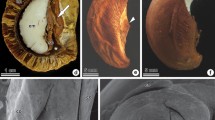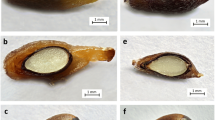Summary
Marginal and central florets of the capitula of tansy ragwort Senecio jacobaea yield different kinds of fruit. The central (“disk”) achenes are lighter (x±SE=199±5μg), more numerous (x±SE=58±0.6 achenes per head), and are equipped with a pappus aiding wind transport and rows of trichomes aiding animal transport. The marginal (“ray”) achenes are heavier (x±SE=286±7μg), less numerous (virtually invariant at 13 achenes per head), and lack dispersal structures. Whereas disk achenes are relased shortly after they mature, ray achenes are retained by the parent for a period of months following maturity.
Germination at constant temperature (20°C) and with alternating light (12 h light: 12 h dark) demonstrated that disk and ray achenes exhibit different germination syndromes. Germination percentage increases linearly with achene fresh weight in both types; for a given weight, disk achenes have a higher germination percentage than ray achenes. Germination time decreases with increasing achene weight in disk achenes, but increases with achene weight in ray achenes.
The germination percentages and germination times for disk and ray achenes diverge progressively with increasing achene weight. The divergence in behavior is a result of diverging patterns of dry matter allocation in the two achene types. Increase in the size of disk achenes favors the embryo fraction, thereby speeding germination while reducing protection. Increase in the size of the ray achenes favors the pericarp fraction, thereby increasing protection while delaying germination.
Reduced germination percentage and germination speed of the ray achenes were shown by experimental manipulation to be caused by physical inhibition by their thicker pericarps.
Dimorphism in ragwort likely speards germination out in space and time, thereby increasing the number of safe sites an individual parent can exploit in disseminating offspring. The syndrome in other heteromorphic composites resembles that of ragwort, generally combining reduced dispersal-delayed germination in the outer achenes and distance dispersal-quick germination in the central achenes. The outer achenes are generally less numerous and larger. Dispersal traits (large numbers, early release and light wieght) are the direct opposite of dormancy traits (small numbers, delayed release and heavier weight). Thus conflicts between the properties determining dormancy and dispersal appear to require separate dormancy and dispersal phenotypes.
Similar content being viewed by others
References
Baker AL (1982) Disk and ray achene development and germination characteristics of tansy ragwort (Senecio jacobaea L.). M.S. Thesis, Washington State University, Pullman
Baker GA, O'Dowd DJ (1982) Effects of parent plant density on the production of achene types in the annual Hypochoeris glabra. J Ecol 70:201–215
Baskin JM, Baskin CC (1976) Germination dimorphism in Heterotheca subaxillaris var subaxillaris. Bull Torrey Bot Club 103:201–206
Becker W (1912) Über die Keimung verschiedenartiger Früchte und Samen bei derselben Spezies. Beih Bot Zbl 29:21–143
Bornemissza GF (1966) An attempt to control ragwort in Australia with the cinnabar moth, Callimorpha jacobaeae L. (Arctiidae, Lepidoptera). Aust J Zool 14:201–243
Burtt BL (1977) Aspects of diversification in the capitulum. In: The biology and chemistry of the Compositae, vol I Heywood VH, Harborne JB, Turner BL (eds) Academic Press, London-New York, pp 41–59
Cameron E (1935) A study of the natural control of ragwort (Senecio jacobaea L.). J Ecol 23:265–322
Cohen D (1966) Optimizing reproduction in a randomly varying environment. J Theor Biol 12:119–129
Cohen D (1967) Optimizing reproduction in a randomly varying environment, when a correlation may exist between the conditions at the time a choice has to be made and the subsequent outcome. J Theor Biol 16:1–14
Colbry VL, Swofford TF, Moore RP (1961) Tests for germination in the laboratory. In: Seeds. The Yearbook of Agriculture. Stefferud A (ed), U.S.D.A. Washington DC, pp 433–443
Flint SD, Palmblad IG (1978) Germination dimorphism and developmental flexibility in the ruderal weed Heterotheca grandiflora. Oecologia (Berlin) 36:33–44
Forbes JC (1977) Population flux and mortality in a ragwort (Senecio jacobaea L.) infestation. Weed Res 17:387–391
Green HE (1937) Dispersal of Senecio jacobaea. J Ecol 25:569
Grime JP, Mason G, Curtis AV, Rodman J, Band SR, Mowforth MAG, Neal AM, Shaw S (1981) A comparative study of germination characteristics in a local flora. J Ecol 69:1017–1059
Harper JL (1965) Establishment, aggression, and cohabitation in weedy species. In: The genetics of colonizing species Baker HG, Stebbins GL (eds), Academic Press, New York-London pp 243–268
Harper JL (1977) Population biology of plants. Academic Press London New York-San Francisco
Harper JL, Lovell PH, Moore KG (1970) The shapes and sizes of seeds. Annu Rev Ecol Syst 1:327–356
Harper JL, Wood WA (1957) Biological flora of the British Isles: Senecio jacobaea L. J Ecol 45:617–637
Jacob F (1977) Evolution and tinkering. Science 196:1161–1166
Koller D, Roth N (1964) Studies on the ecological and physiological significance of amphicarpy in Gymnarrhena micrantha (Compositae). Am J Bot 51:26–35
MacArthur RH (1972) Geographical ecology. Harper and Row New York
McDonough WT (1975) Germination polymorphism in Grindelia squarrosa (Pursh) Dunal. Northwest Sci 49:190–200
McEvoy PB (In press) Seedling dispersion and the persistence of ragwort Senecio jacobaea L. (Compositae) in a grassland dominated by perennial species. Oikos
Meijden E van der, Waals-kooi RE van der (1979) The population ecology of Senecio jacobaea in a sand dune system. J Ecol 67:131–153
Meijden R van der (1976) Het verspreidingsgebied van Senecio jacobaea var nudus Weston. Gorteria 8:57–61
Poole AL, Cairns D (1940) Botanical aspects of ragwort (Senecio jacobaea L.). Bull NZ Dep Sci Indust Res 82:1–61
Salisbury E (1942) The reproductive capacity of plants. Bell and Sons London
Salisbury E (1964) Weeds and aliens, second ed Collins London
Schmidl L (1972) Biology and control of ragwort, Senecio jacobaea L in Victoria, Australia. Weed Res 12:37–45
Sheldon JC (1974) The behaviour of seeds in soil III The influence of seed morphology and the behaviour of seedlings on the establishment of plants from surface-lying seeds. J Ecol 62:47–66
Sheldon JC, Burrows FM (1973) The dispersal effectiveness of the achene-pappus units of selected Compositae in steady winds with convection. New Phytol 72:665–675
Sorenson AE (1978) Somatic polymorphism and seed dispersal. Nature 276:174–176
Southwood TRE (1977) Habitat, the templet for ecological strategies? J Anim Ecol 46:337–365
Stearns SC (1982) The role of development in the evolution of life histories. In: Bonner JT (ed) Evolution and Development. Springer-Verlag, Berlin-Heidelberg-New York pp 237–258
Stebbins GL (1974) Flowering plants: Evolution above the species level. Harvard University Press Cambridge, Mass
Venable DL (1979) The demographic consequences of achene dimorphism in Heterotheca latifolia Buckl. (Compositae): Germination, survivorship, fecundity, and dispersal. Ph D Thesis University of Texas, Austin
Venable DL, Lawlor L (1980) Delayed germination and dispersal in desert annuals: Escape in space and time. Oecologia (Berlin) 46:272–282
Zohary M (1950) Evolutionary trends in the fruiting head of Compositae. Evolution 4:103–109
Author information
Authors and Affiliations
Rights and permissions
About this article
Cite this article
McEvoy, P.B. Dormancy and dispersal in dimorphic achenes of tansy ragwort, Senecio jacobaea L. (Compositae). Oecologia 61, 160–168 (1984). https://doi.org/10.1007/BF00396754
Received:
Issue Date:
DOI: https://doi.org/10.1007/BF00396754




